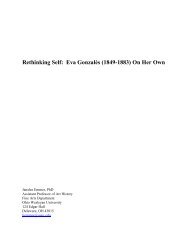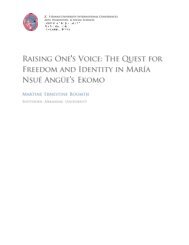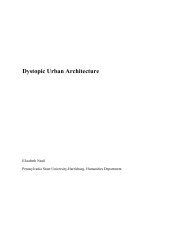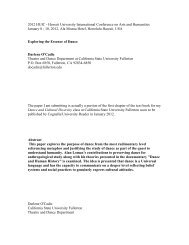Lieder eines armen Mädchens: a Song Cycle for the Cabaret ...
Lieder eines armen Mädchens: a Song Cycle for the Cabaret ...
Lieder eines armen Mädchens: a Song Cycle for the Cabaret ...
You also want an ePaper? Increase the reach of your titles
YUMPU automatically turns print PDFs into web optimized ePapers that Google loves.
pointed way. Fur<strong>the</strong>r, because <strong>the</strong> scenes and songs presented in <strong>the</strong> cabaret were<br />
nothing more than brief vignettes, <strong>the</strong> music and text necessarily had to be free of<br />
excessive artifice: <strong>the</strong> effect of <strong>the</strong> music and text had to be immediate, focused, and<br />
Struve 3<br />
clearly portray <strong>the</strong> intended meaning. The challenge lay in creating poignant, biting<br />
attacks and portraits within a very limited timeframe. Friedrich Hollaender articulated<br />
his philosophy regarding <strong>the</strong> role of cabaret and <strong>the</strong> ideals of <strong>the</strong> art <strong>for</strong>m in an article<br />
appearing in Die Weltbuühne in February of 1932:<br />
Within it (<strong>Cabaret</strong>) <strong>the</strong>re lies an aggressiveness that will <strong>for</strong>ever<br />
distinguish it from all operatic, choral, and symphonic music. <strong>Cabaret</strong> that<br />
fails to take pleasure in <strong>the</strong> attack, that lacks <strong>the</strong> taste <strong>for</strong> battle, is not fit<br />
to live…Under <strong>the</strong> cover of an evening’s relaxing entertainment, cabaret,<br />
like nothing else, suddenly dispenses a poison cookie. Suggestively<br />
administered and hastily swallowed, its effect reaches far beyond <strong>the</strong><br />
harmless evening to make o<strong>the</strong>rwise placid blood boil and inspire a<br />
sluggish brain to think.<br />
The laws inherent to this compressed <strong>for</strong>m demand not only <strong>the</strong> rapid<br />
effect of <strong>the</strong> arresting word and <strong>the</strong> quickly understood gesture, <strong>the</strong>y call<br />
imperiously <strong>for</strong> music that is provocative, short, revealing, essential; in its<br />
rhythm and coloring, in its melody and drama, <strong>the</strong> music must explode in<br />
a lightning flash and can permit itself no time to develop and build…its<br />
mood has to be present in <strong>the</strong> first beats. 4<br />
Much of Hollaender’s philosophy regarding <strong>the</strong> cabaret chanson and its purpose is<br />
already recognizable in <strong>the</strong> music and texts of <strong>Lieder</strong> <strong>eines</strong> Armen <strong>Mädchens</strong>, despite its<br />
early appearance on <strong>the</strong> cabaret stage.<br />
Friedrich Hollaender composed <strong>the</strong> <strong>Lieder</strong> <strong>eines</strong> Armen <strong>Mädchens</strong> <strong>for</strong> Blandine<br />
Ebinger between 1920 and 1924, and <strong>the</strong>se songs were among <strong>the</strong> first per<strong>for</strong>med in <strong>the</strong><br />
cabaret <strong>for</strong> which he wrote both <strong>the</strong> text and <strong>the</strong> music. All told, <strong>the</strong> set comprised<br />
4 Hollaender, Friedrich. “<strong>Cabaret</strong>.” Die Weltbühne 28:5 (February 2, 1932), 169-71. In<br />
The Weimar Republic Sourcebook, ed. Anton Kaes, et. al. Berkely, CA: University of<br />
Cali<strong>for</strong>nia Press, 566-67.







